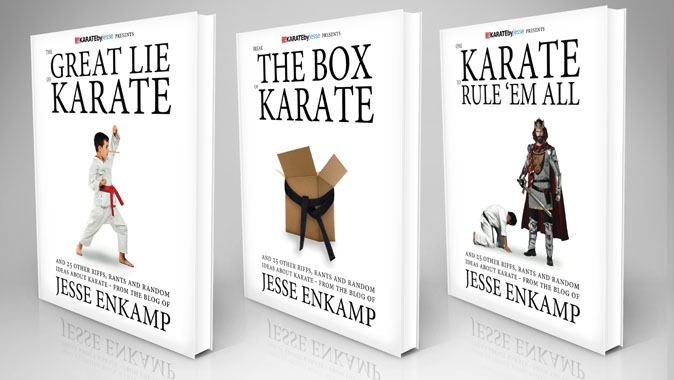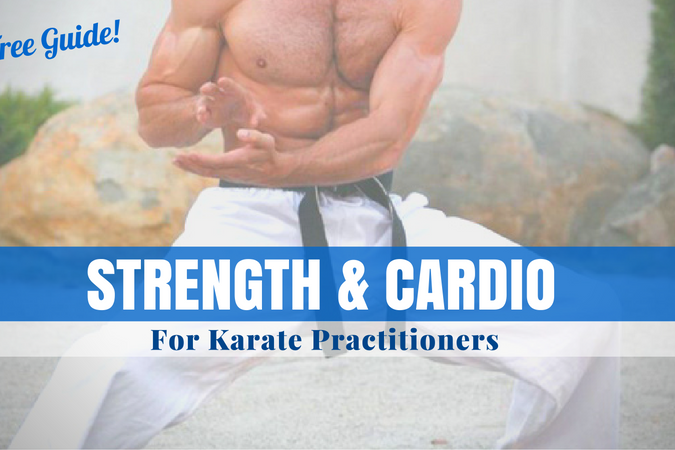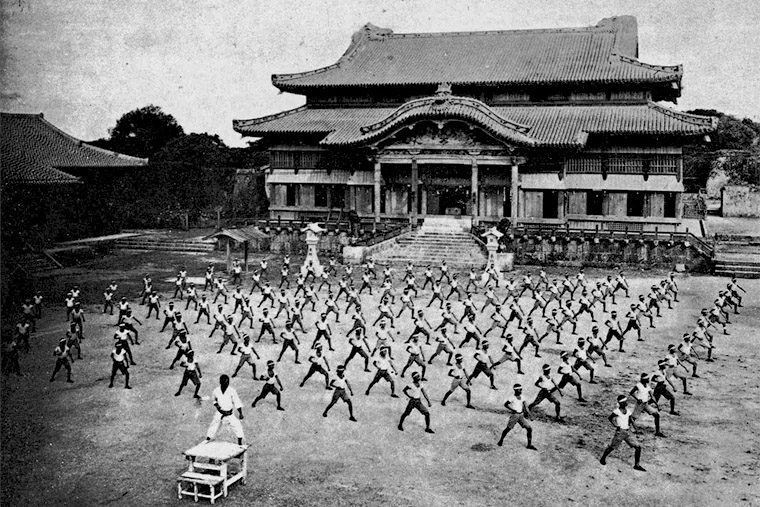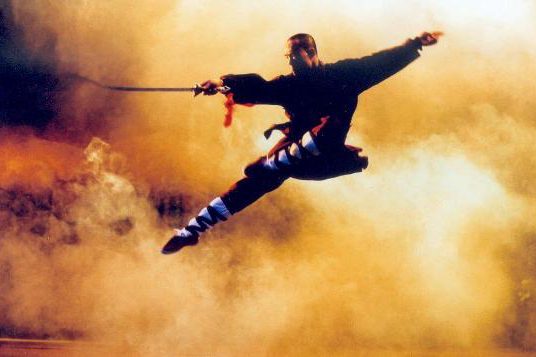Do you like reading Karate books?
Perfect!
Because today, I’ve put together a quick list of a few of my favorite books that every Karate Nerd™ should own.
To save you time, I’ve also added a small blurb about what each book is about, followed by my own personal comments.
Of course I’ve read them all – numerous times!
Check ’em out:
#1: Bubishi: The ‘Bible’ of Karate
Translated & compiled by Patrick McCarthy
“Treasured for centuries by karate’s top masters, Bubishi is a classic Chinese work on philosophy, strategy, medicine and technique as they relate to the martial arts. Referred to as “the bible of karate” by the famous master Chojun Miyagi, for hundreds of years the Bubishi was a secret text passed from master to student in China and later in Okinawa.
No other classic work has had as dramatic an impact on the shaping and development of karate: all of karate’s legendary masters have studied it, applied its teachings or copied passages from it.
This beautiful new hardcover edition features over 250 line drawings, photographs and calligraphy throughout. Along with additional commentary and a new foreword from Patrick McCarthy, the first person to translate the Bubishi into English, this book is an excellent addition to anyone’s library.”
Comments: Okay, here’s the first one on my list – for a reason! Although Bubishi isn’t a physically ‘big’ book, it’s still pretty dense – and super important. Why? Because it’s the earliest written record of a genuine martial arts transmission from China to Okinawa (the birthplace of Karate).
So, historically speaking, the Bubishi is essential to your library.
The stuff you find in the Bubishi , i.e. kata techniques, self-defense, pressure points, combat tactics, herbal medicine, philosophy etc. is exactly what old-school Karate consisted of. This particular translation is by far the best one, because the editor, Patrick McCarthy, is the world’s best Karate researcher.
–> Get it here, amigo!
_______________
#2: The Twenty Guiding Principles of Karate
By Funakoshi Gichin
“Gichin Funakoshi, “the father of karate,” once said that “the ultimate aim of karate lies not in victory nor defeat, but in the perfection of the character of its participants.”
To support this life-long stance and offer guidance to future practitioners, he penned his now legendary twenty principles. While the principles have circulated for years, a translation of the accompanying commentary has never found its way into publication–until now.
As axioms, Funakoshi’s principles are open to various interpretations. “There is no first attack in karate” has occasioned endless discussion about its true meaning. Many of these ambiguities are clarified in the commentary, which is also filled with philosophical musings, fascinating historical episodes, and advice for anyone seeking a better Way.”
Comments: This book is so awesome. Containing the famous “twenty guiding principles of Karate” laid out by the legendary master Funakoshi himself, this timeless collection of wisdom will have you thinking a lot.
I seriously love the authentic feel of the book (physically), and even though the book is actually a lightweight, the content really speaks for itself. I could write a whole book about each single page. Really.
–> Get it here, mate!
_______________
#3: Karate-Do: My Way of Life
By Funakoshi Gichin
“Linking the time when karate was a strictly Okinawan art of self-defense shrouded in the deepest secrecy and the present day, when it has become a martial art practiced throughout the world, is Gichin Funakoshi, the “Father of Karate-do.”
Out of modesty, he was reluctant to write this autobiography and did not do so until he was nearly ninety years of age. Trained in the Confucian classics, he was a schoolteacher early in life, but after decades of study under the foremost masters, he gave up his livelihood to devote the rest of his life to the propagation of the Way of Karate.
In telling of his own famous teachers – and not only of their mastery of technique but of the way they acted in critical situations -the author reveals what true karate is. The stories he tells about himself are no less instructive: his determination to continue the art, after having started it to improve his health; his perseverance in the face of difficulties, even of poverty; his strict observance of the way of life of the samurai; and the spirit of self-reliance that he carried into an old age kept healthy by his practice of Karate-do.”
Comments: Another book by Funakoshi Gichin, and one of the first Karate books I ever read. Unlike most other Karate books, this is more of a “story” type book.
Basically, if you want first-hand accounts of how Funakoshi and his awesome teachers (Itosu and Azato) applied dirty Karate skills in their daily struggle on the unforgiving streets of ancient Okinawa, this is your book. Fascinating old-school Karate stories, with a high re-read value. Love it.
–> Get it here, comrade!
_______________
#4: History and Traditions of Okinawan Karate
By Hokama Tetsuhiro
“Tetsuhiro Hokama is one of the most prolific writers on the history of Okinawa martial arts. Unfortunately for most of us, the majority of his books are written in Japanese! This volume is a noteable exception […].
The first section deals with the history of Okinawan Karate: Origins of Martial Arts, Martial Arts Pioneers, and The Evolution of Modern Martial Arts. All three sections deal exclusively with Okinawan fighting arts and teachers, and there are plenty of photographs throughout, many which have NOT been published in other books on Okinawa karate.
The book includes a training guide section, including one kata demonstrated by Hokama sensei himself. The unique chapters cover things like ‘Ekkinkyogi’ – physical practice and internal power, ‘Kappo’ (rescusitation techniques), ‘Iron Hand’ hardening, ‘Kakie’ (pushing hands), 2-man body-hardening exercises, kata, bunkai and more.
Comments: I have to admit something folks: Hokama sensei is a true badass. How do I know? I’ve visited him many times in Okinawa, training at his dojo, even staying at his house – which has a huge section dedicated to his Karate museum.
So, if you want to experience the written collection of professor Hokama’s amazing historical & technical knowledge – without having your fingers broken (literally!), or giant boards smashed over your head (been there, done that, got the t-shirt) – this book will be perfect for you as an overview of basic Okinawan Karate and its history.
Buy it. Read it twice. Learn it.
–> Get it here, buddy!
_______________
#5: The Essence of Karate
By Funakoshi Gichin
“Gichin Funakoshi is a legendary figure and the founder of Shotokan karate, the most popular style of Japanese karate, with millions of practitioners worldwide. In The Essence of Karate, Funakoshi creates, in his own words, a narrative of modern karate. He explains the philosophical and spiritual underpinnings and includes memories of his own training, as well as recollections of other karate masters and the history of the martial art. He also discusses the importance of winning without fighting, and the reason why many great martial artists improve with age.
The preface has been contributed by Hirokazu Kanazawa, President of the Shotokan Karate-do International Federation (and Funakoshi’s disciple). He fondly writes of his memories of Gichin Funakoshi during his youth and what he learned from the master. In the afterword, the founder’s great-nephew, Gisho Funakoshi, shares previously unknown personal anecdotes about his “Uncle Funakoshi.””
Comments: Yup, Funakoshi Gichin again. You see, apart from being “the grandfather of modern Karate”, he was an insane writer – producing more material than many of his peers. And yes – the material is great.
I actually got this book personally signed by a living Funakoshi family member in Okinawa (as I wrote here), so needless to say, this book is pretty special to me.
The book contains golden nuggets of Karate wisdom, and the physical feel of the book is awesome. I love both the design and the content. The book truly outlines the essence of Karate and should be mandatory reading for today’s Karate youth especially. You’ll know why when you read it.
–> Get it here, hombre!
_______________
#6: Okinawan Karate: Teachers, Styles and Secret Techniques
By Mark Bishop
“Written by a well-known figure in the Martial Arts community noted for his outspokenness, this book is an engaging and rich text, certain to provoke and please. ‘Okinawan Karate’, long sought after by connoisseurs of Okinawan Martial Artsl arts, is the definitive survey and examination of traditional Martial Artsl arts of the island.
With detailed lineage charts of most of the major Okinawan Martial Artsl arts systems, sequential photographs displaying the distinctive techniques of his subjects, solid reportage, and frank quotes from his interview subjects, Okinawan Karate is a complete and encyclopedic source of information.”
Comments: If you have any interest in old styles of Karate, this book is for you. The author, Mark Bishop, basically went everywhere in Okinawa’s traditional Karate community and scribbled down his cool experience – the sum of several face-to-face meetings with a plethora of incredible Karate and Kobudo masters, most of whom are dead now.
The fact that an Okinawan friend of mine (a 7th dan shihan) bought this book for his own study says a lot. The book contains wonderfully rare photos (I’m a sucker for rare Karate photos!) and a great directory at the end too. Highly recommended for history buffs and people who like weird/rare/secret stuff.
–> Get it here, pal!
_______________
#7: Machida-Do: Karate for Mixed Martial Arts (DVD Box)
By Lyoto ‘The Dragon’ Machida
“Lyoto Machida, son of karate master Yoshizo Machida, is one of the top-ranked mixed martial arts competitors in the world. After earning his karate black belt at thirteen, he mastered a number of other martial arts disciplines, including sumo and Brazilian Jiu-Jitsu.
Combining techniques from the various disciplines to form an unorthodox and highly effective fighting style, Machida took the martial arts world by storm, defeating legendary mixed martial artists such as BJ Penn, Rich Franklin, and Tito Ortiz. Now, for the first time, Machida divulges the secrets to his revolutionary fighting system.
Whether you re new to the martial arts or an experienced fighter, Machida-do is for you. Detailing everything from stance to complex combinations to elaborate counterattacks to intricate ground fighting tactics, Machida has left no stone unturned. In Machida-Do, Lyoto Machida shares the fighting system that elevated him to the top of the MMA mountain.”
Comments: An extensiveDVD box featuring Lyoto Machida, the hugely successful point-Karate fighter to become a champion in UFC, the world’s biggest Mixed Martial Arts organization. Wow. In this 4-DVD set he shows exactly which Karate techniques work in the cage… and which doesn’t.
Machida’s evasive style, footwork and classical Karate counters – adapted to the full-contact rules of MMA – make this a must-buy for every serious fighter out there. It also includes ne-waza (ground fighting).
So if you want to be the king of the dojo, this is for you. Believe me!
–> Get it here, bro!
_______________
#8: The Little Black Book of Violence: What Every Young Man Needs to Know About Fighting
By Lawrence A. Kane and Kris Wilder
“Men commit 80 % of all violent crimes and are twice as likely to become the victims of aggressive behavior. The Little Black Book of Violence is written for men ages 15 to 35, and contains more than mere self-defense techniques. This book provides crucial information about street survival that most martial arts instructors don’t even know about. Kane and Wilder explain how to use awareness, avoidance, and de-escalation to help stave off violence.”
Comments: The dojo is a fun place where we laugh, sweat and enjoy some exercise. The street, on the other hand, is a nasty place where we cry, run and scream. At least until you’ve read this book.
If you read this book, you will learn the difference between Karate for the dojo and Karate for the street, by exploring the gritty sides of Karate in this all-encompassing book (as related to self-defense), featuring tons of stuff that your sensei probably won’t/can’t teach you.
Kids, close your eyes – this is real stuff. Contains a lot of street psychology and verbal skills too.
–> Get it here, homie!
_______________
#9: Kata: The Key to Understanding and Dealing with the Japanese
By Boye Lafayette De Mente
“Literally, the form and order of doing things in Japan, “kata” is the cultural conditioning that causes the Japanese to think and react in the way they do. The secret to understanding Japanese business, culture, and society is explained by this cultural framework upon which Japanese behavior and etiquette is built.
Veteran Japanologist Boye Lafayette De Mente explains the concept of kata and offers the reader insight to the art of bowing, the importance of apology, the origin of the Japanese obsession for quality, and other key cultural ideas which, when mastered, unlock the mystery of Japanese professional and social interaction.
Comments: The meaning of the term kata will never be the same again when you’ve read this book. I know, because I read it many times when I lived in Japan.
Although the book has nothing to do with Karate directly, it has everything to do with Karate indirectly, i.e. through Japanese society & culture – which, as we know, serves as the historical backdrop to the evolution of Karate. In other words, if you’re interested in the cultural landscape from which modern Karate flourished, this is the book for you.
Japan is kata, and so is Karate – you just don’t know it yet. But soon you will.
–> Get it here, dude!
_______________
#10: The 3 ‘Best of KARATEbyJesse’ Books
By the world’s handsomest Karate blogger
“Straight from the best Karate blog in the galaxy, comes three long-awaited books from Amazon #1 best-selling author Jesse Enkamp; featuring some of the most popular hand-picked articles of KARATEbyJesse.com on the art, science, knowledge and culture of Karate online. WARNING! Strictly recommended for Karate Nerds™ only! May contain traces of awesome.”
Comments: What? Seriously. Don’t give me that look. Ever since I wrote The Karate Code (which became a #1 ranked Amazon.com best-seller!) people have asked me for new books. So, after letting people vote for their favorite KbJ articles, I edited them and added some new stuff and put them in three awesome books. Get them if you want to support my work. Good karma included. My eternal love too!
–> Get ’em here, you sexy beast!
PS. If you’re tired of books – check out the Seishin gi. Very limited stock left.
_______________
That’s it!
10 epic Karate Nerd™ books.
Happy reading! ; -)
PS. There are MANY more books (and websites) that I recommend in my FREE 7-Day Karate Nerd™ E-mail Guide.













29 Comments